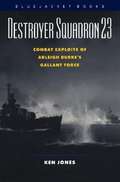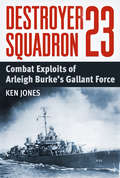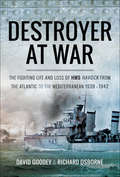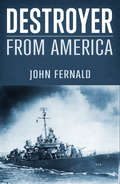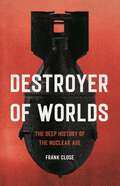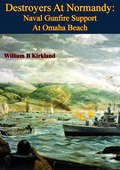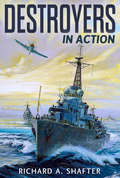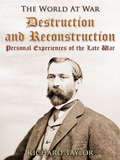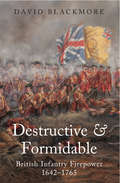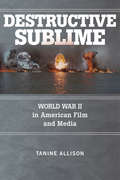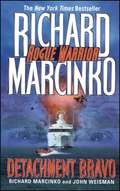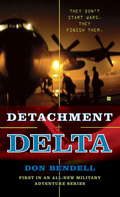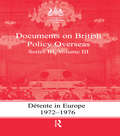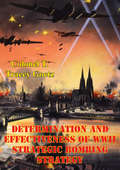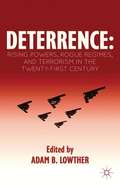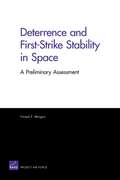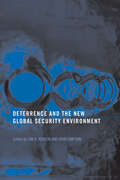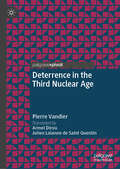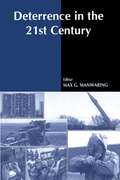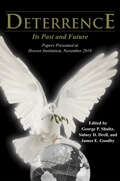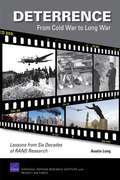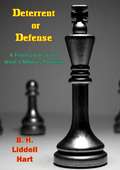- Table View
- List View
Destroyer Squadron 23
by Ken JonesCalled one of the most inspiring stories to come out of World War II when first published in 1959, this epic account of Arleigh Burke's legendary Destroyer Squadron 23 is much more than a story of ships and their tactical deployment. It is a story of men in action--some four thousand of them--and how they lived and fought as a magnificent combat team.Ken Jones not only records their heroic deeds but helps explain what prompted those deeds, including the leadership qualities that fired the men into action. In doing so he brings to life the outfit's fighting spirit--that mysterious combination of qualities inspired by great leaders that wins battles--and the man who led them. Commodore Arleigh Burke was the right man at the right place at the right time; his leadership fused the squadron into a superb combat organization.This book offers a vivid account of the fighting in the South Pacific during one of the most crucial periods of the war. In authentic, minute-by-minute detail drawn from once-secret documents, Jones describes the battles of Tassafaronga, Savo Island, Empress Augusta Bay, and Cape St. George. But the focus throughout is on the men as they meet the test of battle with a common bravery as staunch as any in the Navy's annals. No squadron in any navy is said to have won more battle honors in less time than the Fighting Twenty-third.
Destroyer Squadron 23: Combat Exploits of Arleigh Burke's Gallant Force
by John Kenneth JonesDestroyer Squadron 23, first published in 1959, is the epic account of Commodore Arleigh Burke and the men and ships under his command in the South Pacific in World War II. Burke’s leadership skills and innovative tactics, described in detail in the book, proved crucial to the U.S. defeat of the Japanese navy in the Pacific. Included are 10 pages of maps.
Destroyer at War: The Fighting Life and Loss of HMS Havock from the Atlantic to the Mediterranean 1939–42
by Richard Osborne David GoodeyIt was headline news on 8 April 1942: One of the Navys most famous destroyers, a ship which survived bombs, torpedoes and full scale battles, has been wrecked. That destroyer was HMS Havock, described in another newspaper as Britains No 2 Destroyer of this war second only in fame and glory to the Cossack.Havock had earned her reputation guarding the convoys across the Atlantic in 1939 and at Narvik in the abortive bid to stave off the German occupation of Norway in 1940. Havock was then transferred to the Mediterranean, fighting at the Battle of Cape Spada in 1940 and in 1941 at the Battle of Matapan and in the evacuations of Greece and Crete.Havocks duties in the Med continued, escorting the convoys to the besieged island of Malta and the equally beleaguered garrison at Tobruk. Then in the Battle of Sirte in 1942 Havock was badly damaged and she limped into Malta for repairs. There she was heavy bombed and when Havock made a bid to reach Gibraltar, she was wrecked off Cape Bon. Her crew was captured and imprisoned in the infamous Laghouat internment camp.The authors have tracked down fifty of the surviving crew and from interviews have been able to compile one of the most detailed, and certainly one of the most dramatic, histories of a destroyer during the Second World War. Destroyer at War tells the story of the battles and operations of a famous ship, and its sad destruction, through newspaper reports, official documents, and the words of the men who sailed and fought in HMS Havock as she earned an astonishing eleven battle honors in her brief but glorious career.
Destroyer from America
by John B. FernaldDestroyer from America, first published in 1942, is a fictionalized account of life aboard a naval destroyer on convoy duty in the North Atlantic during the early days of World War II. Although not filled with combat scenes, the book paints an accurate picture of life aboard a destroyer as the men deal with the inclement weather, lost ships, boredom, missed loved ones, and an encounter with a German submarine. Author John B. Fernald served in the Royal Navy Volunteer Reserve during the war, aboard the HMS Newmarket, formerly the USS Robinson of the U.S. Navy, one of the four-stacker destroyers provided to the British before America's entry into the war.
Destroyer of Worlds: The Deep History of the Nuclear Age
by Frank CloseThe thrilling and terrifying seventy-year story—"kinetic, dramatic, and compulsively readable" (Patchen Barss)—of the physicists that deciphered the atom and created the hydrogen bomb Although Henri Becquerel didn&’t know it at the time, he changed history in 1896 when he left photographic plates and some uranium rocks in a drawer. The rocks emitted something that exposed the plates: it was the first documented evidence of spontaneous radioactivity. So began one of the most exciting and consequential efforts humans have ever undertaken. As Frank Close recounts in Destroyer of Worlds, scientists confronting Becquerel&’s discovery had three questions: What was this phenomenon? Could it be a source of unlimited power? And (alas), could it be a weapon? Answering them was an epic journey of discovery, with Ernest Rutherford, Enrico Fermi, Irene Joliot-Curie, and many others jockeying to decipher the dance of particles in a decaying atom. And it was a terrifying journey as well, as Edward Teller and others pressed on from creating atom bombs to hydrogen bombs so powerful that they could destroy all life on earth. The deep history of the nuclear age has never before been recounted so vividly. Centered on an extraordinary cast of characters, Destroyer of Worlds charts the course of nuclear physics from simple curiosity to potential Armageddon.
Destroyers At Normandy: Naval Gunfire Support At Omaha Beach [Illustrated Edition]
by William B. Kirkland John C. ReillyIncludes numerous maps and illustrations.This monograph provides first-hand accounts of Destroyer Squadron 18 during this critical battle upon which so much of the success of our campaign in Europe would depend. Their experience at Omaha Beach can be looked upon as typical of most U.S. warships engaged at Normandy. On the other hand, from the author's research it appears evident that this destroyer squadron, with their British counterparts, may have had a more pivotal influence on the breakout from the beachhead and the success of the subsequent campaign than was heretofore realized. Its contributions certainly provide a basis for discussion among veterans and research by historians, as well as a solid, professional account of naval action in support of the Normandy landings.
Destroyers in Action
by Richard A. ShafterDestroyers in Action, first published in 1945 as part of The U.S. Navy in Action Series, examines some of the important battles waged by the U.S. Navy destroyer fleet (especially those of World War II), and the stories of notable ships such as the Laffy, O'Bannon, Ward, and Prairie. Also included are profiles of the ships' officers and crews and legendary commanders, strategies and tactics used against the enemy, and historic naval conflicts. Author Richard Shafter served as an officer aboard a destroyer in WWII. Included are 11 pages of illustrations.
Destruction and Reconstruction: Personal Experiences Of The Late War (The World At War)
by Richard TaylorIn this unique series, the Civil War comes vividly to life, as those who were there give eye-witness accounts from both sides of the bloody conflict. A sugar farmer and gentleman politician with no military training before the war, General Richard Taylor--son of President Zachary Taylor--plays a major role in the Red River campaign. Out of print since 1879. (Excerpt from Goodreads)
Destructive & Formidable: British Infantry Firepower, 1642–1756
by David Blackmore&“Looks at British infantry doctrine . . . from the British Civil Wars of the seventeenth century up to just before the American War of Independence.&” —British Civil Wars Blog In the seventeenth and eighteenth centuries, the British Army&’s victories over the French at battles such as Blenheim in 1704, Minden and Quebec in 1759, and over the Jacobites at Culloden in 1746, were largely credited to its infantry&’s particularly effective and deadly firepower. For the first time, David Blackmore has gone back to original drill manuals and other contemporary sources to discover the reasons behind this. This book employs an approach that starts by considering the procedures and practices of soldiers in a given period and analyzes those in order to understand how things were done and, in turn, why events unfolded as they did. In doing so, Blackmore has discovered a specifically British set of tactics, which created this effectiveness and allowed it to be maintained over such a long period, correcting many of the misconceptions about British infantry firepower in the age of the musket and linear warfare in a major new contribution to our understanding of an important period of British military history. &“Essential reading for anyone interested in the British army of the 17th and 18th centuries.&”—Military History Monthly
Destructive Sublime: World War II in American Film and Media (War Culture)
by Tanine AllisonThe American popular imagination has long portrayed World War II as the “good war,” fought by the “greatest generation” for the sake of freedom and democracy. Yet, combat films and other war media complicate this conventional view by indulging in explosive displays of spectacular violence. Combat sequences, Tanine Allison argues, construct a counter-narrative of World War II by reminding viewers of the war’s harsh brutality.Destructive Sublime traces a new aesthetic history of the World War II combat genre by looking back at it through the lens of contemporary video games like Call of Duty. Allison locates some of video games’ glorification of violence, disruptive audiovisual style, and bodily sensation in even the most canonical and seemingly conservative films of the genre. In a series of case studies spanning more than seventy years—from wartime documentaries like The Battle of San Pietro to fictional reenactments like The Longest Day and Saving Private Ryan to combat video games like Medal of Honor—this book reveals how the genre’s aesthetic forms reflect (and influence) how American culture conceives of war, nation, and representation itself.
Detachment Bravo
by Richard Marcinko John WeismanFrom top-secret diplomatic tunnels beneath London to the high seas off the Azores, the New York Times bestselling SEAL commando of eight explosive thrillers takes on a lethal group of Irish Republican Army terrorists inROGUE WARRIORDETACHMENT BRAVOThe Rogue Warrior is back in a fast-paced, furious, in-your-face adventure! This time he's on the hunt for a high-tech army that smashed the Good Friday Peace Accord and killed a half dozen American and British CEOs. Launched by two self-financed, new-generation terrorists, this murderous wing of the IRA has an even bigger assault planned -- one that promises to stun the world. Now, along with a special ops team made up of Brits, SEALS, spies, and NSA operatives, Marcinko is determined to stop them, but there are a few unknowns: they don't know the target, they don't know the date, and they don't know where the terror is going down.
Detachment Bravo (Rogue Warrior #10)
by Richard Marcinko John WeismanFrom top-secret diplomatic tunnels beneath London to the high seas off the Azores, the New York Times bestselling SEAL commando of eight explosive thrillers takes on a lethal group of Irish Republican Army terrorists in ROGUE WARRIOR DETACHMENT BRAVO The Rogue Warrior is back in a fast-paced, furious, in-your-face adventure! This time he's on the hunt for a high-tech army that smashed the Good Friday Peace Accord and killed a half dozen American and British CEOs. Launched by two self-financed, new-generation terrorists, this murderous wing of the IRA has an even bigger assault planned -- one that promises to stun the world. Now, along with a special ops team made up of Brits, SEALS, spies, and NSA operatives, Marcinko is determined to stop them, but there are a few unknowns: they don't know the target, they don't know the date, and they don't know where the terror is going down.
Detachment Delta
by Don BendellThese elite Delta Force heroes are highly trained killing machines. Their leader is Charlie Strongheart, a Lakota warrior. His assignment: enter Iran and eliminate a terrorist threat. But when Strongheart is betrayed by those he thought he could trust, he finds himself alone in the heart of the beast.
Detainee Abuse During Op TELIC: 'a Few Rotten Apples'?
by Timothy WoodThis book reviews the nature of the alleged abuse committed by the UK military forces, exploring the legal paradigm in which the abuse allegedly occurred; the morality of those accused; and the robustness of the accusation of a 'policy of abuse'.
Detente in Europe, 1972-1976: Documents on British Policy Overseas, Series III, Volume III (Whitehall Histories)
by G. Bennett K. A. HamiltonDrawing on records of the Foreign and Commonwealth Office, this work focuses on Britain's role in the Mutual and Balanced Force Reductions in Vienna, and British policy towards the Soviet Union and its satellites. British reactions to detente between the superpowers are charted.
Determination And Effectiveness Of Wwii Strategic Bombing Strategy
by Colonel T. Tracey GoetzWith the collapse of France in 1940, American (US) and British (UK) leadership became keenly aware that the continued security of their nations required the defeat of the Axis powers, particularly Germany. The Allies chose a strategy utilizing a combination of various military actions, most notably a combined bomber offensive (CBO). The CBO would be carried out through a combination of US daylight precision and UK night area bombing.The purpose of this paper is to show why the Allies chose this strategy and evaluate its success. To accomplish this task, the paper will first describe the events that brought about the conflict and the strategy. Crowl's Questions are used as a framework to analyze the factors that influence strategy development and adoption and will illustrate why Allied leaders chose this path. This is followed by a detailed description of the campaign. The principles of war (mass, objective, offensive, maneuver, surprise, security, simplicity, unity of command, and economy of force) are accepted as proven methods for employing forces in combat and are used to evaluate the CBO's effectiveness The paper closes with a summary of the findings and doctrinal implications.The paper will show the Allies adopted US daylight precision and UK night area bombing based on leadership's belief that it could most effectively reduce Germany's means of war and hasten its earliest possible defeat. The Allies successfully achieved this objective primarily through adherence to the principles of mass, objective, offensive, and maneuver.
Determining Core Capabilities in Chemical and Biological Defense Science and Technology
by Development Committee on Determining Core Capabilities in Chemical Biological Defense ResearchThe goal of the U. S. Department of Defense's (DoD's) Chemical and Biological Defense Program (CBDP) is to provide support and world-class capabilities enabling he U. S. Armed Forces to fight and win decisively in chemical, biological, radiological, and nuclear (CBRN) environments. To accomplish this objective, the CBDP must maintain robust science and technology capabilities to support the research, development, testing, and evaluation required for the creation and validation of the products the program supplies. The threat from chemical and biological attack evolves due to the changing nature of conflict and rapid advances in science and technology (S&T), so the core S&T capabilities that must be maintained by the CBDP must also continue to evolve. In order to address the challenges facing the DoD, the Deputy Assistant Secretary of Defense (DASD) for Chemical and Biological Defense (CBD) asked the National Research Council (NRC) to conduct a study to identify the core capabilities in S&T that must be supported by the program. The NRC Committee on Determining Core Capabilities in Chemical and Biological Defense Research and Development examined the capabilities necessary for the chemical and biological defense S&T program in the context of the threat and of the program's stated mission and priorities. Determining Core Capabilities in Chemical and Biological Defense Science and Technology contains the committee's findings and recommendations. It is intended to assist the DASD CBD in determining the best strategy for acquiring, developing, and/or maintaining the needed capabilities.
Deterrence
by Adam B. LowtherWith many scholars and analysts questioning the relevance of deterrence as a valid strategic concept, this volume moves beyond Cold War nuclear deterrence to show the many ways in which deterrence is applicable to contemporary security. It examines the possibility of applying deterrence theory and practice to space, to cyberspace, and against non-state actors. It also examines the role of nuclear deterrence in the twenty-first century and reaches surprising conclusions.
Deterrence and First-Strike Stability in Space
by Forrest E. MorganSpace stability appears to be eroding as a growing number of states acquire the ability to degrade or destroy U.S. space assets. The United States needs a coordinated national space deterrence strategy designed to operate on both sides of a potential adversary's cost-benefit decision calculus. Future research will determine the most effective and affordable mix of strategies, policies, and systems for strengthening space deterrence.
Deterrence and the New Global Security Environment
by John Simpson Ian R. KenyonThis collection of papers rigorously examines the current place of deterrence in international security relations, delivering the best of contemporary thinking. This is a special issue of the leading journal Contemporary Security Policy. It shows how and why nuclear deterrence was the central organizing mechanism for international security relations in the second half of the twentieth century. It has been replaced by a new global security environment in which the central role of deterrence, both nuclear and otherwise, appears to have diminished. The Cold War has been succeeded by a new state of play. This book will be of interest to students of military and naval history and security studies.
Deterrence in the Third Nuclear Age (Rethinking Political Violence)
by Pierre VandierThis book explains the evolution of nuclear doctrines along the 20th century and the beginning of the 21st in an evolving geopolitical context, particularly the potential use of nuclear weapons to blackmail or aggressively sanctuarize territorial gains, as it has been demonstrated by Russia in Ukraine. After five decades of the Cold War, known as the first nuclear age, the world attempted to eliminate nuclear weapons through treaties and disarmament initiatives. This marked the second nuclear age, where peace efforts fostered hope that these weapons might become obsolete. However, during the first decade of the 21st century, cracks began to appear in this ambition, notably with North Korea’s withdrawal from the Nuclear Non-Proliferation Treaty. Today, the nuclear factor dominates the geopolitical landscape in a new and alarming way. New players have emerged, some of whom do not adhere to the rules established during the Cold War. Russia, for example, resorted to nuclear blackmail against the West in the early days of its invasion of Ukraine. This marks the onset of a third nuclear age—characterized by greater complexity, increased volatility, and the presence of new actors who are dangerously navigating their learning curves.
Deterrence in the Twenty-first Century
by Max G. ManwaringThis anthology argues that facing the diverse threats in the 'new world disorder' requires a new look and new approaches. The requirement is to establish that contemporary deterrence demands replacing the old 'nuclear theology' with new policy and strategy to deal with the myriad state, non-state, and trans-national nuclear and non-nuclear menaces that have heretofore been ignored or wished away.
Deterrence: Its Past and Future—Papers Presented at Hoover Institution, November 2010
by George P. Shultz James E. Goodby Sidney D. DrellDrawn from the third in a series of conferences the Hoover Institution at Stanford University on the nuclear legacy of the cold war, this report examines the importance of deterrence, from its critical function in the cold war to its current role. Recognizing that today's international environment is radically different from that which it was during the cold war, the need is pressing to reassess the role of nuclear weapons in deterrence in the world of today and to look ahead to the future.
Deterrence: Lessons from Six Decades of Rand Deterrence Research
by Austin LongSince its inception six decades ago, the RAND Corporation has been one of the key institutional homes for the study of deterrence. This book examines much of this research for lessons relevant to the current and future strategic environment. It is therefore part intellectual history and part policy recommendation, intended to encourage debate and discussion on how deterrence can best be incorporated into U.S. strategy.
Deterrent or Defense: A Fresh Look at the West’s Military Position
by B. H. Liddell HartHere is a much-needed assessment and summing-up on four current strategic situation by B. H. Liddell Hart, the leading military analyst of our time. Taking a clear, hard look at Western defense capabilities and strategic planning, particularly as they are embodied in NATO, he has come up with suggestions for radical but vital revisions in our defense policies.Fifteen years have elapsed since Captain Liddell Hart forecast the consequences of atom-bomb diplomacy. Now, as the NATO powers move uneasily forward in the 1960’s, he shows how the development of the H-bomb—and, indeed, the multiplication in general of nuclear weapons on both sides—has become on the one hand, increasingly self-inhibiting, and, on the other, increasingly precarious as a protective insurance policy, especially in view of the development of log-range missiles.The natural consequences of the current nuclear parity is nuclear nullity. Thus, the nuclear deterrent, in which the West has put so much trust, is fading except as a deterrent to its own kind of action. But the Western powers have not yet come to grips with the problem of finding an adequate and effective replacement for this “fading deterrent.” As a result, the West now finds itself gravely hampered in any attempt to resist the more subtle forms of aggression and pressure.Having carefully analyzed the ailment, the author offers a hopeful cure, demonstrating how the weakness of the West’s present position can be remedied without an intolerable outlay in strain and cost.
